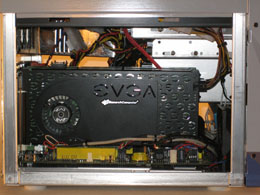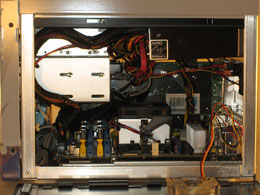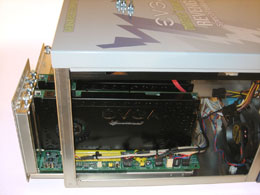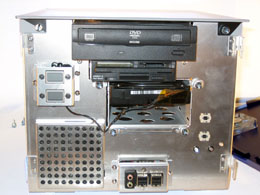Exclusive: SLI Head-to-Head: Monarch Micro-ATX vs. Shuttle SFF
by Jarred Walton on March 6, 2006 8:56 AM EST- Posted in
- Systems
Monarch Hornet Revenge - Construction
The design and construction of the Hornet Pro chassis is relatively good. It has all the necessary features, a few useful extras, and very few obvious shortcomings. The frame and panels are made of lightweight aluminum, with a thickness of 1 mm. The 1 mm aluminum is definitely thicker and more durable than many cheaper aluminum cases, so it's nice to see. There are no overly sharp edges, and a few areas have folded edges to help add strength to the structure. The end result is a good balance between weight and durability.
Thumbscrews are used in quite a few locations to make it easier to work with the system. Both side panels are secured by thumbscrews, as is the top panel. However, before you can remove the top panel, you need to remove the front panel. The front panel is secured by four small screws on the sides of the case, and given their location, we certainly wouldn't want thumbscrews used in their place. Some sort of latching mechanism that didn't require tools at all would have been nice, but the flipped side of that argument is that latches are more prone to breakage. Even with the screws removed, it's a bit difficult to remove the front panel - you have to slide it out and down, but it takes a bit more effort than you might think. Once you have the front panel off, you can then remove the two additional thumbscrews on the front of the case and pop off the top. At this point, you have access to the drive bays, and once more, we find thumbscrews used to secure the hard drive cage. There are probably more screws and thumbscrews holding the case together than is strictly required, but we would rather have a couple of extras for added durability than fewer screws and a flimsier chassis.
With all the panels removed, you now have relatively unobstructed access to the internals. There are two 40mm fans at the top-left rear of the case, one more 40 mm fan at the mid-right rear, a 60 mm fan on the right side panel, and an 80 mm fan at the front bottom-left corner. The power supply also has two fans inside it, both 60 mm in size. Add in a CPU fan, chipset fan, and one fan on each of the graphics cards, and you end up with a decent amount of airflow. Having that many fans may seem like overkill, but its smaller size combined with the high performance (and accompanying high power draw) of the CPU and GPUs almost certainly make them necessary. Unfortunately, it also makes the system less than quiet, but few ultra high-end computers would qualify as quiet, and the system isn't atrociously loud either.
One of the cool additions to the case that definitely helps out when you need to work on the internals is the use of a slide-out motherboard tray. Remove the four thumbscrews on the rear of the case, and you can slide the motherboard and expansion cards out of the case. This doesn't work perfectly, since the various cables connecting the front panel to the motherboard initially prevent you from fully removing the tray, but this is sufficient to give you access to the thumbscrews that secure the expansion cards, and it also keeps those same screws hidden from view during normal use. If you do need to remove the motherboard, it will also make installing a new motherboard much easier - and remember that since this is a standard uATX form factor design, it is conceivable that you could upgrade the system in the future while keeping the case. The same can't be said of more traditional SFF designs, since the proprietary nature of their motherboards almost always means that you are stuck with using the same motherboard for the life of the system. (We don't think that's as bad as it sounds, since you can always sell off your old SFF and just buy a new one if the need ever arises.)
The biggest complaint that we have about the case design is that there are simply a lot of screws, making it a bit slower to assemble or disassemble. Since we're not the ones doing the assembling, we can't complain too much, but if you're interested in purchasing the case on its own, we would rate it merely as decent. However, there really aren't that many good uATX cases around, and this is one of the better uATX designs that we've seen. Another minor issue with the Revenge is that the vinyl wrap does make it a bit more difficult to remove the side panels and top. The vinyl wrap can also start to peel if you're not careful, particularly around the screws. As long as you exercise a bit of care, though, this shouldn't present any serious problems.
Summary
The bottom line is that the Hornet Pro case is well-built, and it does exactly what it needs to do. The carrying handle on the front of the case suggests that you might want to take this to LAN parties, and having a more durable chassis is certainly desirable for such use. There are compromises that can be made either way: easier to open/upgrade/maintain versus more durability and restricted access. The Hornet Pro balances the various design aspects quite well, and the end result is a stylish, relatively transportable, sturdy system. We certainly wouldn't be embarrassed to walk into a LAN party using such a system! Monarch Computers also deserves some credit for being the very first company to market a Micro-ATX SLI system; some of the credit also goes to EVGA, but either way, we are happy to see such a powerful uATX configuration.
Not surprisingly, the final price for this powerful little box isn't cheap: $3627 plus shipping and tax as appropriate gets you everything that we've talked about here, along with a three-year on-site warranty and 24/7 technical support. You can ditch the additional warranty and save $170, but we're hesitant to recommend that with a system such as this - you wouldn't want to drive a new car around without insurance, would you? Besides, this is far cheaper than car insurance.
Keep in mind that this system falls squarely in the "Dream" category, so the price really isn't that bad. Using our Real-Time Pricing Engine, the cost of all the components purchased separately comes out to about $3000. When you add in the customized case, system assembly and testing, and three-year on-site warranty, Monarch Computer Systems is making a profit, but they're not charging any more than I would charge for the same thing. Their prices are very reasonable, and as the adage goes, you certainly get what you pay for. Even if you don't want the Revenge SE, you can certainly find a quality system at Monarch Computers that will meet your requirements and budget.
If you're looking to cut costs (and performance) a bit to save some money, I put together an alternate Hornet Pro SLI configuration containing the type of system that I would want to buy. The major changes involve ditching the FX-57 and going with dual cores, courtesy of the Opteron 170 retail CPU. I also opted for two higher capacity 250GB WD 16MB hard drives, and decided to go with two 7800 GT cards instead of the more powerful 7800 GTX KO. (I, too, am waiting to see the launch of the 7900 cards.) Since gaming is almost certainly a focus, a better sound card is also desirable, and with the 7800 GT, there should be room to install such a card. Here, I opted for the more economical Audigy SE rather than one of the new X-Fi cards. This system is definitely slower than the Revenge, but it's $1100 cheaper and should still have ample performance for gaming, not to mention three times as much storage space and a second CPU core to help out with multitasking.
If you like my above choices, you can choose those parts on the configuration page, or you're always welcome to change things as you see fit. There aren't many places that I would trust to build a high-performance system for me, but Monarch is definitely on that list. Again, with an assembly fee of only $59, it's definitely a great way to get all the benefits of a custom-built PC without having to do all the work, and you don't run the risk of DOA parts, since Monarch tests everything before shipping.
The design and construction of the Hornet Pro chassis is relatively good. It has all the necessary features, a few useful extras, and very few obvious shortcomings. The frame and panels are made of lightweight aluminum, with a thickness of 1 mm. The 1 mm aluminum is definitely thicker and more durable than many cheaper aluminum cases, so it's nice to see. There are no overly sharp edges, and a few areas have folded edges to help add strength to the structure. The end result is a good balance between weight and durability.
Thumbscrews are used in quite a few locations to make it easier to work with the system. Both side panels are secured by thumbscrews, as is the top panel. However, before you can remove the top panel, you need to remove the front panel. The front panel is secured by four small screws on the sides of the case, and given their location, we certainly wouldn't want thumbscrews used in their place. Some sort of latching mechanism that didn't require tools at all would have been nice, but the flipped side of that argument is that latches are more prone to breakage. Even with the screws removed, it's a bit difficult to remove the front panel - you have to slide it out and down, but it takes a bit more effort than you might think. Once you have the front panel off, you can then remove the two additional thumbscrews on the front of the case and pop off the top. At this point, you have access to the drive bays, and once more, we find thumbscrews used to secure the hard drive cage. There are probably more screws and thumbscrews holding the case together than is strictly required, but we would rather have a couple of extras for added durability than fewer screws and a flimsier chassis.
 |
 |
| Click on images to enlarge. | |
With all the panels removed, you now have relatively unobstructed access to the internals. There are two 40mm fans at the top-left rear of the case, one more 40 mm fan at the mid-right rear, a 60 mm fan on the right side panel, and an 80 mm fan at the front bottom-left corner. The power supply also has two fans inside it, both 60 mm in size. Add in a CPU fan, chipset fan, and one fan on each of the graphics cards, and you end up with a decent amount of airflow. Having that many fans may seem like overkill, but its smaller size combined with the high performance (and accompanying high power draw) of the CPU and GPUs almost certainly make them necessary. Unfortunately, it also makes the system less than quiet, but few ultra high-end computers would qualify as quiet, and the system isn't atrociously loud either.
 |
 |
| Click on images to enlarge. | |
One of the cool additions to the case that definitely helps out when you need to work on the internals is the use of a slide-out motherboard tray. Remove the four thumbscrews on the rear of the case, and you can slide the motherboard and expansion cards out of the case. This doesn't work perfectly, since the various cables connecting the front panel to the motherboard initially prevent you from fully removing the tray, but this is sufficient to give you access to the thumbscrews that secure the expansion cards, and it also keeps those same screws hidden from view during normal use. If you do need to remove the motherboard, it will also make installing a new motherboard much easier - and remember that since this is a standard uATX form factor design, it is conceivable that you could upgrade the system in the future while keeping the case. The same can't be said of more traditional SFF designs, since the proprietary nature of their motherboards almost always means that you are stuck with using the same motherboard for the life of the system. (We don't think that's as bad as it sounds, since you can always sell off your old SFF and just buy a new one if the need ever arises.)
The biggest complaint that we have about the case design is that there are simply a lot of screws, making it a bit slower to assemble or disassemble. Since we're not the ones doing the assembling, we can't complain too much, but if you're interested in purchasing the case on its own, we would rate it merely as decent. However, there really aren't that many good uATX cases around, and this is one of the better uATX designs that we've seen. Another minor issue with the Revenge is that the vinyl wrap does make it a bit more difficult to remove the side panels and top. The vinyl wrap can also start to peel if you're not careful, particularly around the screws. As long as you exercise a bit of care, though, this shouldn't present any serious problems.
Summary
The bottom line is that the Hornet Pro case is well-built, and it does exactly what it needs to do. The carrying handle on the front of the case suggests that you might want to take this to LAN parties, and having a more durable chassis is certainly desirable for such use. There are compromises that can be made either way: easier to open/upgrade/maintain versus more durability and restricted access. The Hornet Pro balances the various design aspects quite well, and the end result is a stylish, relatively transportable, sturdy system. We certainly wouldn't be embarrassed to walk into a LAN party using such a system! Monarch Computers also deserves some credit for being the very first company to market a Micro-ATX SLI system; some of the credit also goes to EVGA, but either way, we are happy to see such a powerful uATX configuration.
Not surprisingly, the final price for this powerful little box isn't cheap: $3627 plus shipping and tax as appropriate gets you everything that we've talked about here, along with a three-year on-site warranty and 24/7 technical support. You can ditch the additional warranty and save $170, but we're hesitant to recommend that with a system such as this - you wouldn't want to drive a new car around without insurance, would you? Besides, this is far cheaper than car insurance.
Keep in mind that this system falls squarely in the "Dream" category, so the price really isn't that bad. Using our Real-Time Pricing Engine, the cost of all the components purchased separately comes out to about $3000. When you add in the customized case, system assembly and testing, and three-year on-site warranty, Monarch Computer Systems is making a profit, but they're not charging any more than I would charge for the same thing. Their prices are very reasonable, and as the adage goes, you certainly get what you pay for. Even if you don't want the Revenge SE, you can certainly find a quality system at Monarch Computers that will meet your requirements and budget.
If you're looking to cut costs (and performance) a bit to save some money, I put together an alternate Hornet Pro SLI configuration containing the type of system that I would want to buy. The major changes involve ditching the FX-57 and going with dual cores, courtesy of the Opteron 170 retail CPU. I also opted for two higher capacity 250GB WD 16MB hard drives, and decided to go with two 7800 GT cards instead of the more powerful 7800 GTX KO. (I, too, am waiting to see the launch of the 7900 cards.) Since gaming is almost certainly a focus, a better sound card is also desirable, and with the 7800 GT, there should be room to install such a card. Here, I opted for the more economical Audigy SE rather than one of the new X-Fi cards. This system is definitely slower than the Revenge, but it's $1100 cheaper and should still have ample performance for gaming, not to mention three times as much storage space and a second CPU core to help out with multitasking.
If you like my above choices, you can choose those parts on the configuration page, or you're always welcome to change things as you see fit. There aren't many places that I would trust to build a high-performance system for me, but Monarch is definitely on that list. Again, with an assembly fee of only $59, it's definitely a great way to get all the benefits of a custom-built PC without having to do all the work, and you don't run the risk of DOA parts, since Monarch tests everything before shipping.











13 Comments
View All Comments
JarredWalton - Monday, March 6, 2006 - link
HDCP support is a graphics/display issue. As has been reported, HDCP is not supported on any current retail graphics cards. It's also not supported under Windows XP. We should start seeing HDCP enabled cards (meaning, with the necessary decryption chip) in the near future. The GPUs are ready, but they still need the appropriate chip soldered onto the boards.Personally, I'm really not happy with HDCP at all, so I'm doing my best to avoid it. 1280x720 DivX looks quite nice and runs flawlessly on current hardware. Here's an example from the olympics (18GB compressed to 4.5GB 1280x720):
http://images.anandtech.com/reviews/multimedia/tvt...">2006 Olympics Men's Hockey Gold Match
AGAC - Tuesday, March 7, 2006 - link
Hey, what's to love about HDCP. That said, it seems that we just will have to swallow that frog... I mean, DivX does look nice indeed. The problem is availability of mainstream content. I think it's going to be a very cold day in hell before you can walk in the regular video rental and get the latest blockbuster title in beautiful DivX 1280x720.DHCP will be broken, we all know that. It only harms the legal user because one will have to upgrade video cards, monitors and god knows what more will not be HDCP compliant. Thanks for the your tip and simpathy. Keep up the good work.
AGAC
DigitalFreak - Monday, March 6, 2006 - link
NT